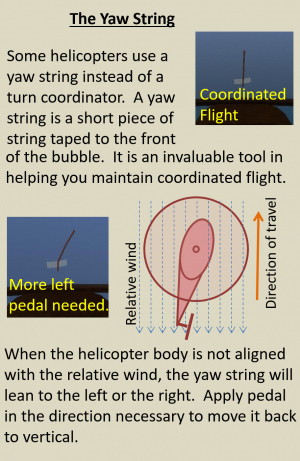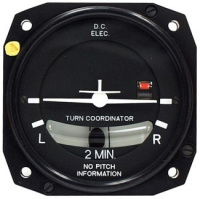SL Helicopter Flying Handbook/Basic Flight Maneuvers
SECTION 8. Basic Flight Maneuvers
Contents
1 Cruise Flight
There are four fundamentals of flight upon which all maneuvers are based: straight-and-level flight, turns, climbs and descents. The initial goal of the student pilot should be to master these four fundamentals and be able to perform them based on an accurate feel and understanding of how the helicopter will perform.
Some general guidelines are as follows:
- Make control inputs slowly and smoothly. Abrupt control movements risk exceeding an aircraft limitation and departing controlled flight.
- Anticipate the effect of environmental conditions. The helicopter will not react the same way, or require the same control inputs at high altitude compared to sea-level.
- Understand the limitations and flight characteristics of the helicopter you are flying:
- In left turns, there is increased torque, so more anti-torque (left pedal) will be required.
- In right turns, there is decreased torque, so less anti-torque (right pedal) will be required.
- Normal helicopter landings to a hover require increased helicopter power.
- Always leave a way out if a maneuver must be aborted for some reason.
1.1 Straight-and-Level Flight
In straight-and-level cruise flight, the goal should be to fly a constant heading at a constant speed without gaining or losing altitude. In addition, the aircraft should be horizontally level and well coordinated. Use collective to control altitude using the VSI (Vertical Speed Indicator) as reference. If a descent or climb is indicated, increase or decrease collective to maintain altitude. Airspeed is controlled with the forward and backwards cyclic. Move the cyclic forward to increase airspeed, and ease back on the cyclic to reduce airspeed. Meanwhile, heading control is maintained with left and right cyclic. Use left/right cyclic opposite to any drift either by reference to the heading indicator, or the horizon to keep the helicopter level and on course.
The pedals are used to maintain coordination. This is normally done with the turn coordinator (Figure 2), but some aircraft may use a yaw string Figure 1. Coordination using the turn coordinator is performed with reference to the black ball, usually at the bottom of the instrument.
When using the inclinometer, pedal should be applied on the side to which the ball moves. Think "step on the ball".
1.2 Turns
Turns should be made primarily with the cyclic, using the yaw string to maintain coordination with the pedals as described above. In very steep turns, it may be necessary to increase collective slightly in the turn.
1.3 Normal Climbs
1.4 Normal Descents
2 Hovering
There are two types of hovering. In Ground Effect (IGE) hovering occurs in ground effect within a few meters of a surface (land, water, or a flat prim) and Out of Ground Effect (OGE) hovering occurs at altitude away from any surface. While hovering in general requires more power (collective) than other phases of flight, OGE hovering requires significantly more power than IGE hovering, and may be impossible depending on how heavily loaded the helicopter is. Cyclic inputs in a hover should be small and controlled taking into account delay between input and the reaction of the helicopter. Use collective to control hight. It is important to learn to anticipate the reaction of the helicopter in response to an input. Over-controlling is a common problem for the beginning helicopter pilot. Forward hover taxi is performed by a very slight forward positioning of the cyclic. In general all hover taxiing should be performed with no more than a dot-width of movement from the center on the cyclic control display.
2.1 Vertical Takeoff to a Hover
Picking up to a hover is performed by slowly raising the collective until the helicopter becomes light on the skids. Pedal should be applied to stop any rotation, and cyclic should be applied to stop any lateral or forward/back motion. Considerable left pedal may be required in the pick-up to counteract torque from the main rotor.
2.2 Set Down from a Hover
Setting down from a hover essentially the reverse of a pickup. Slowly lower collective letting helicopter settle. As collective is lowed, right pedal may be necessary due to the reduction in torque.
2.3 Hovering Turn
2.4 Forward Hovering Flight
2.5 Sideward Hovering Flight
3 Taxiing
3.1 Hover Taxi
3.2 Air Taxi
An air taxi is used to move quickly from one point to another on an airport. Begin an air taxi like a normal takeoff, but lower collective slightly to maintain a height of 10 to 20 meters over the airport while pitching with cyclic for approximately 50 mph. To exit an air taxi and land, apply back cyclic, down collective and ride pedal as necessary. Then make a normal landing to hover.
3.3 Surface Taxi
4 Takeoffs
4.1 Normal Takeoffs from a Hover
Normal takeoffs should begin in a hover with an adequate obstacle free area ahead of the helicopter. From a hover, apply forward cyclic and allow helicopter to accelerate forward in ground effect. At about 30 mph, the helicopter will achieve ETL (Effective Translational Lift) allowing the helicopter to climb (see Section 8 for details on ETL). Some brief aft cyclic at 40 mph may be necessary. Control airspeed with forward cyclic to maintain a best climb airspeed of about 50 mph. Applying too much forward cyclic will reduce climb performance. Raise collective to increase rate of climb, but do not exceed the maximum manifold pressure of 29 inches (red line).
4.2 Takeoffs from the Surface
5 Landings
5.1 Normal Landings to a Hover
Begin a normal landing by reducing air speed to bout 50 mph and lowering the collective to maintain an approximately 500 foot per minute descent. Choose a target spot for your landing, keeping that spot at approximately the same place on the window. As you approach your touchdown spot, slowly decrease airspeed with back cyclic, and descent rate with up collective. Maintain above 30 mph until just before touchdown to avoid vortex ring state. As you transition to a hover, you will need additional up collective and left pedal to compensate for the torque.

